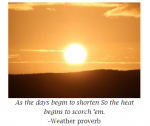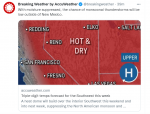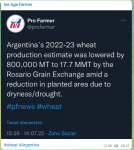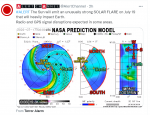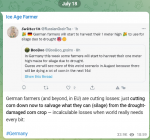northern watch
TB Fanatic
War, Weather Endanger Global Food Supplies, Farm Leaders Say; Disruption to Ukraine's output plus poor weather in the U.S. and South America are two crises, Syngenta CEO says at Wall Street Journal Global Food Forum
Tuesday, June 28, 2022, 3:17 PM ET
By Jesse Newman and Patrick Thomas
Wall Street Journal
CHICAGO—War and weather are imperiling global food supplies, according to U.S. agriculture officials and executives, as rising food prices drive shortages and protests around the world.
The pressures are playing out this year as conflict in Eastern Europe disrupts exports from Ukraine, one of the world’s top crop producers, and drought and poor weather afflict major crop-growing regions.
“We’ve actually got two crises,” said Erik Fyrwald, chief executive of pesticide and crop-seed maker Syngenta, at The Wall Street Journal’s Global Food Forum on Monday. “The food-security crises and the climate crises.”
Mr. Fyrwald said weather extremes are growing, with heat, drought or flooding challenging farmers in the U.S., Europe, Australia and India. That has been exacerbated, he said, by Russia’s war in Ukraine, which has upended world grain markets and pushed up food prices across the world.
Rising food prices are prompting unrest, as disruptions in the flow of crops from Ukraine compound existing stress on global supplies of grains and other goods. The head of the United Nations World Food Program has warned outright food shortages are possible in 2023 if Russia continues to block Ukraine’s crop exports.
Even among the world’s wealthiest countries, higher food prices have been taking a toll. U.S. grocery prices in May rose nearly 12% over the past 12 months, the largest annual increase since April 1979, according to the Labor Department. Prices increased 7.4% at restaurants and other food venues outside the home, also marking a more-than-four-decade increase.
“It is very serious,” said Mr. Fyrwald. Food prices “will keep going up until and unless we can get product out through the Black Sea in the south of Ukraine.”
Ukraine’s global wheat exports, which along with Russia had accounted for nearly one-third of the global total, are projected to be cut in half this year, according to the USDA. Russia’s invasion helped drive wheat prices to record levels in March, and while futures prices have declined 27% since then, they remain about one-fifth higher since the beginning of the year.
“There is just not going to be enough supply of certain ingredients,” said Florian Schattenmann, chief technology officer for agricultural giant Cargill Inc., speaking at the Journal event on Tuesday. The war in Ukraine has strained availability of ingredients such as sunflower oil used in baby formula, spurring companies to have to reformulate their products, he added.
On Monday, U.S. Agriculture Department Secretary Tom Vilsack called for Ukrainian ports in the Black Sea to be opened to export grain out of the war-torn country to help ease the food-supply crunch. Trading needs to resume to free up storage space for the country’s farmers, he said, and the U.S. needs to look for ways for it to increase its own crop production.
Mr. Vilsack also discouraged export bans enacted by countries such as India, which recently banned wheat exports to shore up its domestic food supply.
Russia is destroying grain production in Ukraine, said Mr. Vilsack, speaking at the Journal event Monday. “They are making it hard for farmers to plant and grow their crops.”
Poor weather including in South America is putting more strain on agricultural regions that have grown more important to maintaining world food supplies given the conflict in Ukraine.
In the U.S., wet and windy conditions in parts of the Midwest slowed planting for many corn and soybean farmers last month. The wet conditions were followed by a heat wave earlier this month that killed thousands of cattle in Kansas and prompted concern for U.S. production of crops such as corn and soybeans.
Dryness, meanwhile, is battering farmers and ranchers in Western states, with drought affecting more than 78% of the American West, according to the U.S. Drought Monitor. Western rivers and reservoirs have contracted, threatening water supplies for farmers in places such as California, where the latest dry spell has pushed farmers to bulldoze thousands of acres’ worth of almond orchards and close decades-old dairies.
As conflict continues, Mr. Fyrwald said Syngenta is working with farmers in Ukraine but also continuing to supply Russian farmers with seeds and chemicals. Some agriculture companies, including Syngenta and Bayer AG, and grain traders, such as Cargill, have continued to sell seeds and handle crops in Russia despite pressure to sever ties after the invasion of Ukraine. Companies cite humanitarian grounds for their decisions to keep operating certain parts of their business in Russia, which is expected to increase its wheat exports from a year ago, according to the USDA.
“Snygenta has looked at it and decided that we serve farmers everywhere in the world,” Mr. Fyrwald said. “We are not political.”
The USDA earlier this month projected global wheat exports would come in 2.6% higher for the coming crop marketing year, while the International Grains Council also forecast a modest increase in world-wide wheat production. Wheat prices have also declined recently, with European Union farmers progressing faster than usual with their spring harvest on improved weather conditions.
Mr. Fyrwald said Syngenta is also working with farmers, governments and others to promote practices that enrich soil and capture more carbon while at the same time increasing yields and reducing greenhouse-gas emissions.
The USDA’s Mr. Vilsack also said the U.S. needs to look for ways to increase its own crop production, to help make up for the shortfall in global grain supplies.
“Every generation of Americans get tested,” Mr. Vilsack said, adding that such is the case now with the pandemic and its aftermath, climate change and the war in Ukraine. “They are significant challenges, but there is significant capacity for us to emerge stronger.”
Write to Jesse Newman at jesse.newman@wsj.com and Patrick Thomas at Patrick.Thomas@wsj.com
War, Weather Endanger Global Food Supplies, Farm Leaders Say - WSJ
Tuesday, June 28, 2022, 3:17 PM ET
By Jesse Newman and Patrick Thomas
Wall Street Journal
CHICAGO—War and weather are imperiling global food supplies, according to U.S. agriculture officials and executives, as rising food prices drive shortages and protests around the world.
The pressures are playing out this year as conflict in Eastern Europe disrupts exports from Ukraine, one of the world’s top crop producers, and drought and poor weather afflict major crop-growing regions.
“We’ve actually got two crises,” said Erik Fyrwald, chief executive of pesticide and crop-seed maker Syngenta, at The Wall Street Journal’s Global Food Forum on Monday. “The food-security crises and the climate crises.”
Mr. Fyrwald said weather extremes are growing, with heat, drought or flooding challenging farmers in the U.S., Europe, Australia and India. That has been exacerbated, he said, by Russia’s war in Ukraine, which has upended world grain markets and pushed up food prices across the world.
Rising food prices are prompting unrest, as disruptions in the flow of crops from Ukraine compound existing stress on global supplies of grains and other goods. The head of the United Nations World Food Program has warned outright food shortages are possible in 2023 if Russia continues to block Ukraine’s crop exports.
Even among the world’s wealthiest countries, higher food prices have been taking a toll. U.S. grocery prices in May rose nearly 12% over the past 12 months, the largest annual increase since April 1979, according to the Labor Department. Prices increased 7.4% at restaurants and other food venues outside the home, also marking a more-than-four-decade increase.
“It is very serious,” said Mr. Fyrwald. Food prices “will keep going up until and unless we can get product out through the Black Sea in the south of Ukraine.”
Ukraine’s global wheat exports, which along with Russia had accounted for nearly one-third of the global total, are projected to be cut in half this year, according to the USDA. Russia’s invasion helped drive wheat prices to record levels in March, and while futures prices have declined 27% since then, they remain about one-fifth higher since the beginning of the year.
“There is just not going to be enough supply of certain ingredients,” said Florian Schattenmann, chief technology officer for agricultural giant Cargill Inc., speaking at the Journal event on Tuesday. The war in Ukraine has strained availability of ingredients such as sunflower oil used in baby formula, spurring companies to have to reformulate their products, he added.
On Monday, U.S. Agriculture Department Secretary Tom Vilsack called for Ukrainian ports in the Black Sea to be opened to export grain out of the war-torn country to help ease the food-supply crunch. Trading needs to resume to free up storage space for the country’s farmers, he said, and the U.S. needs to look for ways for it to increase its own crop production.
Mr. Vilsack also discouraged export bans enacted by countries such as India, which recently banned wheat exports to shore up its domestic food supply.
Russia is destroying grain production in Ukraine, said Mr. Vilsack, speaking at the Journal event Monday. “They are making it hard for farmers to plant and grow their crops.”
Poor weather including in South America is putting more strain on agricultural regions that have grown more important to maintaining world food supplies given the conflict in Ukraine.
In the U.S., wet and windy conditions in parts of the Midwest slowed planting for many corn and soybean farmers last month. The wet conditions were followed by a heat wave earlier this month that killed thousands of cattle in Kansas and prompted concern for U.S. production of crops such as corn and soybeans.
Dryness, meanwhile, is battering farmers and ranchers in Western states, with drought affecting more than 78% of the American West, according to the U.S. Drought Monitor. Western rivers and reservoirs have contracted, threatening water supplies for farmers in places such as California, where the latest dry spell has pushed farmers to bulldoze thousands of acres’ worth of almond orchards and close decades-old dairies.
As conflict continues, Mr. Fyrwald said Syngenta is working with farmers in Ukraine but also continuing to supply Russian farmers with seeds and chemicals. Some agriculture companies, including Syngenta and Bayer AG, and grain traders, such as Cargill, have continued to sell seeds and handle crops in Russia despite pressure to sever ties after the invasion of Ukraine. Companies cite humanitarian grounds for their decisions to keep operating certain parts of their business in Russia, which is expected to increase its wheat exports from a year ago, according to the USDA.
“Snygenta has looked at it and decided that we serve farmers everywhere in the world,” Mr. Fyrwald said. “We are not political.”
The USDA earlier this month projected global wheat exports would come in 2.6% higher for the coming crop marketing year, while the International Grains Council also forecast a modest increase in world-wide wheat production. Wheat prices have also declined recently, with European Union farmers progressing faster than usual with their spring harvest on improved weather conditions.
Mr. Fyrwald said Syngenta is also working with farmers, governments and others to promote practices that enrich soil and capture more carbon while at the same time increasing yields and reducing greenhouse-gas emissions.
The USDA’s Mr. Vilsack also said the U.S. needs to look for ways to increase its own crop production, to help make up for the shortfall in global grain supplies.
“Every generation of Americans get tested,” Mr. Vilsack said, adding that such is the case now with the pandemic and its aftermath, climate change and the war in Ukraine. “They are significant challenges, but there is significant capacity for us to emerge stronger.”
Write to Jesse Newman at jesse.newman@wsj.com and Patrick Thomas at Patrick.Thomas@wsj.com
War, Weather Endanger Global Food Supplies, Farm Leaders Say - WSJ


































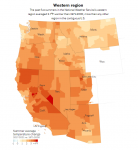
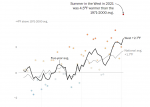
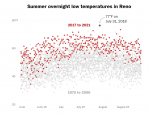













/cloudfront-us-east-2.images.arcpublishing.com/reuters/K5I42HPQFVKR3HAROXQDZ7SIZI.jpg)
















